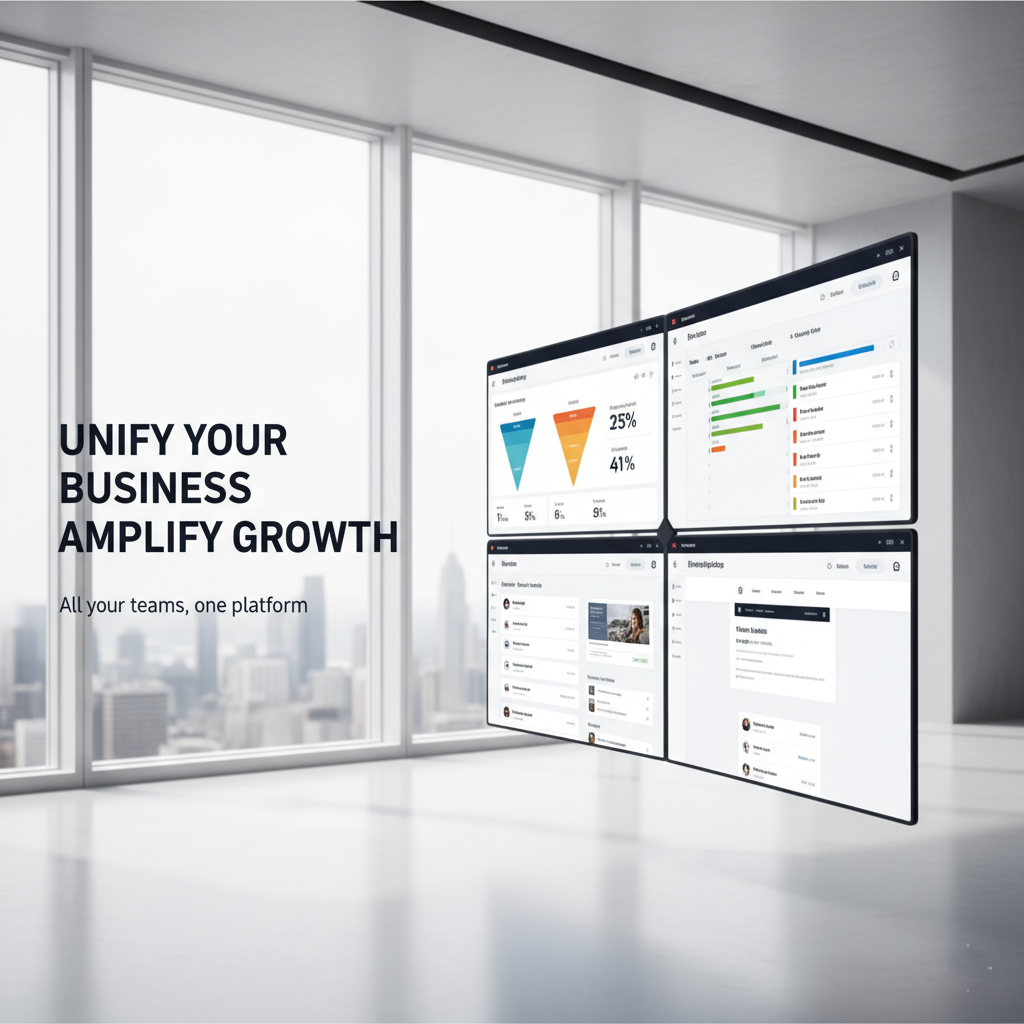hubspot
HubSpot for Marketing, Sales, and Service
We build enterprise-grade HubSpot setups that connect your marketing, sales, and service teams, helping you drive pipeline, improve data accuracy, and scale in a controlled way

Core Capabilities That Matter
HubSpot is a single platform for marketing, sales, service, website, and operations on top of one CRM. That means cleaner handoffs, fewer gaps, and consistent reporting across teams. We focus on the capabilities people use every day and the controls ops needs to keep the system clean.
Forms, ads, email, journeys, lead scoring that ops can actually maintain. Multi-touch attribution that sales can trust.
Sequences, tasks, inbox, quotes, and forecasting. Lead-to-opportunity handoff with SLAs and alerts.
Tickets, SLAs, knowledge base, CSAT, and NPS. Omnichannel inbox and automation for triage.
Secure, fast, multi-language sites tied to CRM segments. Content staging and rollback.
Native sync to major systems, data quality jobs, and dedupe. Custom code actions and calculated fields.
What You Get with Our HubSpot Implementation
We deliver a complete HubSpot setup, from data foundation to team enablement.
Foundations
We design the data model (objects, properties, lifecycle). In addition, we set users, teams, roles, permissions, and consent tracking.
CRM data is migrated or synced (e.g., Salesforce, Microsoft Dynamics). For example, we clean, enrich, and normalize fields so reports and routing are accurate and trustworthy.
Data and Integrations
Journeys and Assets
Teams get the essentials: forms, emails, pages, and sales sequences. Then, lead routing runs with SLA timers and alerts so nothing is delayed.
Lifecycle and funnel reports match your stages. As a result, campaign ROI, velocity, and pipeline health are clear.
Measurement
Enablement and Governance
Role‑based training with runbooks. Changes go through sandbox and change control. Finally, quarterly health checks remove bloat.
HubSpot Integrations Without Limits
HubSpot connects to hundreds of systems. With Reply Group, we go further—CRM, ERP, data warehouse, commerce, or custom stacks.
We build integrations using HubSpot APIs, and where gaps exist, we design custom connectors.
Stable sync rules that hold under load
Error handling and monitoring you can trust
Governance so integrations don’t drift over time
Typical Use Cases We Deliver
We help solve common business challenges with a focused HubSpot setup, ensuring a direct path to measurable outcomes.
Global Lead Management
Account-Based Marketing
Partner or Multi-brand Demand Gen
Sales Acceleration
Customer Onboarding
Website on CMS Hub
Privacy and Compliance by Default
HubSpot includes GDPR consent tracking, cookie banners, and data residency options. From day one, we configure forms, lawful basis, cookie scanning, and audit logs, and align with your DPO and IT security.
GDPR consent on forms and emails
Cookie banner with scanning and consent mode
Audit logs and permission reviews
Data residency aligned with your region

all-in-one platform
Why HubSpot with Like Reply
Where it fits best:
- Mid-market and divisions of large groups that need speed and control.
Distributed teams with shared assets, reporting, and clear permissions.
Businesses seeking to consolidate fragmented marketing and CRM platforms.
When we recommend something else:
For highly customized B2B environments tightly coupled with Salesforce infrastructure, Salesforce Marketing Cloud or Account Engagement may be more efficient.
For organizations deeply integrated with Adobe Experience Cloud, Marketo remains a coherent choice.
Guidance for Your HubSpot Platform
Selecting the right HubSpot tier can feel complex, but we make it simple by aligning it with your business goals and operational needs. The ideal platform configuration is a balance between your current requirements and your future growth plans. We design a plan that aligns functionality with your needs today while keeping the platform ready to scale as you grow.
| Scenario | Recommended Hubs | Tier | Rationale of the Solution |
|---|---|---|---|
Small marketing team starting freshYou need to automate basic marketing tasks, generate and capture leads, and control costs while your business grows. | Marketing Hub Starter + CRM | Starter | This tier is the most cost-effective entry point. It provides essential tools for email marketing, basic lead journeys, forms, and ad management. The CRM is free, and the combination gives you the foundation to build your database and begin automating outreach. |
A Growing B2B Company with an Expanding Sales TeamYour focus is on improving sales efficiency, gaining deeper insights into your funnel, and aligning marketing efforts with sales outcomes. | Marketing Hub Professional + Sales Hub Professional + CRM | Professional | The most common fit for growing businesses. It unlocks powerful capabilities like multi-touch attribution, custom reporting, and marketing automation. For sales, it adds deal pipelines, sequences, playbooks, and forecasting, providing the tools needed to shorten sales cycles and improve lead conversion. |
A Multi-brand, Multi-region Enterprise with Strict GovernanceYou need to manage complex, distributed operations with a high degree of security, control, and data integrity across multiple teams and markets. | Full Platform (Marketing, Sales, Service, Operations, CMS) | Enterprise | Such tier is designed for large-scale, complex environments. It provides sandboxes for safe development, advanced permissions and user roles, and the ability to create custom objects to match your unique data model. It offers the governance and control required to manage a global organization while standardizing processes and reporting. |
Costs We Account for Upfront
Beyond the base platform costs, we help you understand and budget for the fees people often forget, which can affect your total cost of ownership. We provide a full audit of your needs related to:
- Extra Seats: Fees for additional sales or service users.
- Sandboxes: Dedicated testing environments for safe development.
- API Limits: Access to higher API call limits for complex integrations.
- CMS Add-ons: Costs for additional themes or features.
- Phone Numbers: Fees for local calling and SMS.
- Data Retention: Policies and costs for data backup.
Our process ensures there are no surprises, so you can make an informed decision based on clear ROI.
Ready for a high-quality HubSpot deployment?
Let’s discuss your business goals and how a strategic HubSpot implementation can help you achieve them. We’ll provide a clear roadmap and an upfront estimate.
Read our Blog
Frequently Asked Questions
What is HubSpot, and why do I need it?
HubSpot is a unified growth platform (CRM + Marketing Hub + Sales Hub + Service Hub + CMS + Operations Hub) that centralizes customer data, automates campaigns, aligns sales & marketing, and powers reporting. With it, teams can eliminate data silos, streamline handoffs, and scale operations reliably.
Can we keep Salesforce or another CRM when adopting HubSpot?
Yes. We design a sync strategy where HubSpot acts as the automation and reporting layer, while Salesforce remains the system of record. We carefully manage ownership of data fields, ensure bidirectional synchronization, and prevent duplication or conflict.
How long does a HubSpot migration or implementation take?
Typically, 4 to 12 weeks, depending on:
volume & complexity of data to migrate
number of marketing and sales assets to rebuild
integrations with external systems
required customizations (custom objects, workflows, etc.)
We always begin with data clean-up and architecture, which often dictates the timeline.
Which HubSpot tier (Starter / Professional / Enterprise) should we choose?
Use Enterprise only if you require sandboxes, highly granular permissions, advanced reporting, or custom objects across teams. For most B2B / mid-market companies, Professional offers everything you need (multi-touch attribution, automation, custom reporting) without paying for features you don’t use.
How do you ensure GDPR, data privacy and compliance in HubSpot?
We configure subscription types, consent logs, cookie banners, DSR (data subject request) workflows, and retention policies in line with your regional regulations. We document every change and align with your DPO or IT for audits and policy reviews.
What are the common pitfalls in HubSpot projects—and how do you avoid them?
The most frequent blockers are:
Undefined lifecycle stages or journey ownership
Undefined data governance (who owns which field)
Poor lead routing rules
Unclear SLAs between marketing and sales
We address these first in any implementation, so the technical execution doesn’t stall.
Can HubSpot integrate with our existing systems and data stack?
Yes. HubSpot has APIs to connect to CRMs, ERPs, data warehouses, e-commerce platforms, etc. If an API doesn’t exist, we build a custom connector. We also design stable sync rules and error monitoring so integrations remain robust under scale.
What ongoing maintenance or governance is required after implementation?
After go-live, we conduct quarterly health checks, optimize data hygiene, sunset unused fields/workflows, and enforce change control (e.g. sandbox / staging). We train internal teams and empower them to evolve the platform safely.


